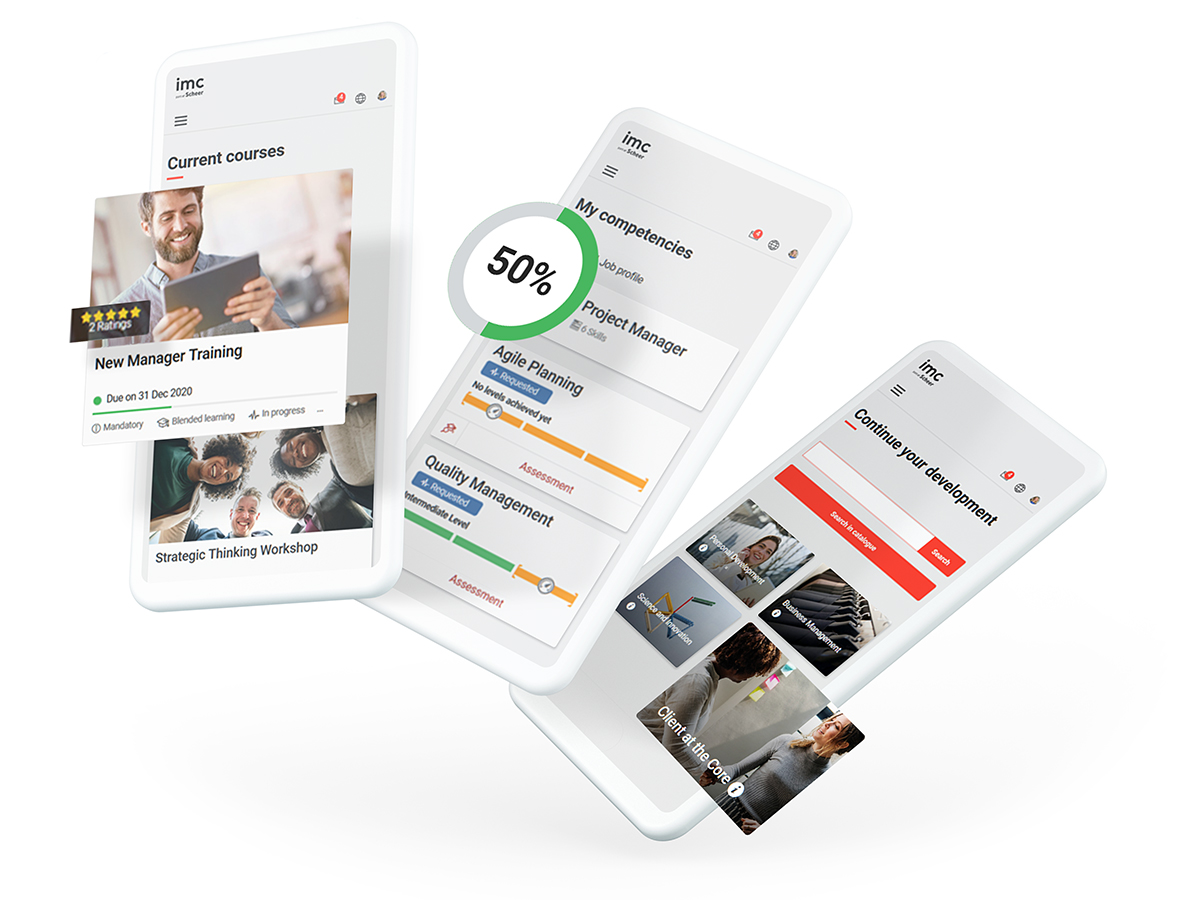
Navigating Change: the Importance of Future Skills
Strategic skills development for companies and individuals in a dynamic working world
What skills does a company need in order to remain successful and improve its ability to respond effectively in a constantly changing world? If we could answer this question with a definitive list, the discussion surrounding “future skills” would be very short.
But, alas, it’s not that simple. There is no universally definitive answer. We can, at most speak only in approximate terms. And therein lies the challenge.
The world of work is in constant flux, shaped by technological advances, changing expectations and ever-new business models. Faced with this highly dynamic and uncertain environment, companies need to get future-ready to ensure they remain successful. And central to this are future skills. These are skills that employees and teams require in order to remain actively in control in a constantly changing world. Our experts advise companies and organisations on how to approach this complex topic.

Uwe Hofschröer, Head of Learning Strategy Consulting at imc
Uwe Hofschröer and his team advise companies at the strategic level on learning objectives, learning formats, and learning content. “There are two layers of uncertainty on this subject,” he says. “Firstly, future skills are, by definition, dynamic. They relate to something that won’t become relevant until some point in the future. And secondly, they describe ‘supra-disciplinary skills’ that don’t relate to any current tasks or challenges affecting employees right now. But that’s not a reason not to engage with the subject.”
Self-directed learning and self-organised learning processes
Companies must take care not to confine their focus on future skills purely to the strategic level. They must follow the matter through to the individual level,
because skills are something developed by and in individual employees. Hence, the focus is on the individual’s ability to successfully navigate change. And that’s something that can be acquired only through overcoming real challenges.
Setting employees “future skills” as a learning task and providing them resources is not enough.
This is especially so since “future skills” transcend subject expertise. They are about enabling employees to navigate new, previously unknown challenges with confidence. They include communication skills, teamwork, critical thinking, and problem-solving skills. They also involve leadership in uncertain situations and the ability to engage successfully with new technologies.
To ensure employees can navigate future challenges in a self-directed manner, the learning process itself should instill self-organised learning as a core value.
Self-organised learning processes do, however, require a clear framework and must be aligned with the company’s strategy, objectives, and challenges. As Hofschröer explains: “In our experience, dealing effectively with the uncertainties surrounding future skills requires an interplay between the ‘company’ level and the ‘individual’ level.” In his view, there are three core aspects to this:

Defining goals and visions based on the company’s own corporate strategy, on market analyses, and on the specific environment in which the company operates. The key is not to treat future skills as a one-off, top-down project but to give employees an active role.

Reflection and operationalisation: Teams and leadership personnel have a key role to play in the development of future skills. Why? Because they are in a position to articulate the challenges in their work clearly and in detail. How? By organising learning processes to deal with their specific challenges. The company can support them with workshops on learning potential, coaching programmes, or training in methodologies like action mapping.

Building up capacity and integrating future skills into learning offerings: A one-off, standardised solution won’t do, because skills are acquired by individuals and are therefore highly dynamic. The company therefore needs to enable skill development in an integrated manner – in various learning environments and at different levels. This allows employees to develop skills in a way that matches their specific needs and learning situations.
Learning strategies and awareness campaigns as key components
The starting point should be a comprehensive awareness campaign. The aim here is to communicate the importance of future skills and strengthen the strategic framework for their development. It’s vital to get the team leaders on board here. It’s important to recruit them as multipliers and give them the tools they need to foster future skills in their teams.
At the learning strategy level, companies can define targeted formats and methods that integrate future skills into existing and new learning programmes. The formats and methods should foster self-organised learning, data literacy, creative problem solving, and social cooperation. This can, for example, be achieved in product training courses and onboarding programmes by using group work and projects.
The results are blended learning scenarios that promote self-directed learning and employee collaboration. This involves providing clear guidelines and structures to increase the likelihood of success.

Having a long-term perspective is key
It’s crucial not to treat future skills as a one-off matter. Future skills are an ongoing process that must be embraced at both the company and the individual level. “Set it up right, and you’ll create a self-perpetuating cycle of learning,” Hofschröer says. Surveys, monitoring, and focus group interviews are the tools of choice here.
Learning analytics also has a lot to offer here. Learning management systems (LMS) are ideal as evaluation tools. They are very effective at pinpointing and closing learning gaps. And they facilitate feedback and control at the overall company level, ensuring that the defined vision is achieved.
Companies that follow this long-term, strategic approach are better equipped to manage the challenges of the constantly changing working world. Future skills are the key to having agency and responding effectively in a volatile, uncertain, complex, and ambiguous world. They are therefore an important focus of skills development for every organisation.

Summary
Companies today are faced with the fundamental question of how to prepare for an unpredictable future. The importance of skills that go beyond mere knowledge is growing. Skills are the sum total of real-world abilities that are acquired by mastering specific challenges. The term “future skills” addresses this by focusing on skills that enable individuals and organisations to deal effectively with change and uncertainty.
This approach is not new. It has its parallel in the long-standing discussion of overarching key competencies – skills instrumental to meeting needs at both the individual and societal level. “Future skills” is a more recent term. It picks up on this idea, focusing on the various requirements arising from current societal and technological changes. In an unpredictable and fast-changing world, the quest for skills that can unlock the future is of the utmost importance.

Employment trends
Employee-led L&D (Learning & Development) can be used to combat the recently identified trend of 'quiet quitting'. Get all the insights here.

Psychological Safety as Prerequisite for Learning Organisations
Psychological safety sounds like a fluffy feel-good topic: all employees should feel safe. But there's more to it than that. Psychological safety is a basic requirement for any organisation wanting to develop positively.

Contact person
I joined the imc newsroom team in 2021. As a journalist my heart beats for content and storytelling.
I’m excited to figure out how e-learing and digitization affect the future of work. My task is to create content to talk about and I’m always looking for trends.
Privately I love to travel and eat Tapas.
Topics: E-Learning Trends, Corporate Social Responsibility, Press and Influencer Relations

Implementing a New Learning Platform: First Impressions Count!
Communication, pro-active employee motivation strategies and quality content as the keys to successful LMS implementation
“Not another new system!” “But we’ve tried this before”. Eye-rolling. These are just some of the sadly all too common employee reactions companies encounter when they announce the implementation of a new IT system.
Learning management systems (LMS) are not immune to this. But many of the pitfalls can be avoided through careful planning – and careful communication planning in particular.

“It seems ‘learning management system’ is a dirty word at our organisation.” This sobering statement was uttered recently by a client who was looking to implement a new LMS. Hardly the stuff of motivation. The client knew even before the project began that it would have to revisit an ugly legacy.
So, what had happened here? It turned out that something had gone badly wrong with the implementation of the client’s old learning platform. And they wanted to undo the damage by implementing a new one. Unfortunately, the whole idea of learning and professional development using an LMS had by then created such ill-feeling throughout the company that the new project manager knew he had an uphill battle on his hands.
Red flags: Common pitfalls when implementing an LMS
Exactly what had gone wrong in this particular case is a story for another day. But generally speaking, there are several reasons why the implementation of a learning platform might fail.
The most common of these boil down to poor communication and insufficient thought given to the target audience. The good news is that many of these pitfalls can be avoided.

Lack of early engagement with stakeholders
If you involve your key stakeholders too late or not at all, then resistance is a virtual certainty. It’s important to get everyone on board. Top level management, team leaders, the works council, HR, internal IT and, most importantly, rank and file employees. All of these groups need to be factored into the decision-making and planning process and informed early on.

Inadequate communication: “Why do we even need an LMS?”
Why do I need it, and what’s expected of me? If the project team can’t provide satisfactory answers to these fundamental questions from employees, they shouldn’t be surprised if the uptake is less than enthusiastic. The benefits and objectives of the learning management system need to be made clear and transparent to everyone.
And, as we know from communication and marketing, it takes multiple touchpoints to truly get the message across. A single email announcing “We have a new LMS” isn’t going to cut it. Instead, you need to reach out to your staff on multiple occasions and actively draw them into the new system.

Cluttered and unappealing design
Here too, first impressions are everything. The LMS must align with the company’s corporate identity. It doesn’t hurt for it to look modern and engaging either. The Daimler Academy is a good example of this done well.
Having a clearly structured user interface and design in keeping with the company’s CI will do wonders for employee acceptance. An unclear navigation system, on the other hand, will quickly result in confusion and frustration.









Not enough content in the LMS – or none at all
Imagine this: The company has done the big communication campaign. It has trumpeted the new system far and wide. And finally, the moment has arrived, and it’s ready to use. The employees log in, encounter a fancy UI design, do the first training module, and then – nothing. A dead end. There’s just the one training module, nothing else.
It may sound obvious, but a learning platform without learning content is not an awful lot of use to employees. An LMS needs to have a decent range of high-quality, employee-relevant content right from the word go. If it doesn’t, it will soon be dismissed as irrelevant and will not be used effectively.

Not another password to remember! And what’s my user ID anyway?!
Nobody likes complicated logins! Ideally, the LMS should be integrated with existing IT systems via single sign-on (SSO) authentication. Complicated login processes create further barriers to use.
Lack of employee enablement and motivation
When it comes to a new LMS, you need to take your employees with you and actively motivate them to use it. That involves more than merely telling them why they should use the system. They also need to know what they’re allowed to do with it and what sort of learning times are involved. And, of course, they need to be shown how the system works.
Failure to provide sufficient resources and user guidance can lead to uncertainty and low acceptance. But the real key is to go beyond mere enablement and actually make employees want to use the system. The aim is to make them feel motivated so that they enjoy using it and look forward to new content.
One way of doing that is to use quizzes about the company. Or little giveaways with QR codes that lead directly to the learning platform.
But what does this look like in practice?
The best approach is always to avoid the pitfalls before they happen. And that means thorough planning and preparation and putting together a detailed communication and action plan. So, what does this look like? We’ll be presenting a customer case study by way of best practice example in our next article.

Diary of an LMS
If an LMS wrote a diary - what would it say?
We thought about that and share some tips for LMS professionals, told a little differently...

Informal learning: Everyday hero of work
“Formal learning is like riding a bus. Informal learning is more like cycling.” We explain what this means and share some key facts and recomemndations

More about our LMS
If you would like to learn more about imc's Learning Management, check here for more information.

Contact person
I have been working in the Marketing & Communication Team at imc since March 2019.
Communication, creative content and social media are my passion. "KISS - Keep it short and simple" is my credo.
To explain complex content in an understandable way and thus make the topic of e-Learning accessible to everyone is an exciting challenge every day.
Privately I love to read, play poker and travel a lot.
I am always happy to receive feedback or suggestions.

Cohort-based Learning: Learning Together Beats going it Alone
What cohort-based learning is all about, and why learning online and learning together are not mutually exclusive.
Doing e-learning from the comfort of your home PC has many benefits. But it’s very much a solitary experience: no interaction, and no peers to keep you motivated and spur you on.
But thanks to cohort-based learning, it doesn’t have to be that way. With cohort-based learning, you can combine the benefits of group dynamics with PC-based self-learning.

Definition: What is cohort-based learning?
“Cohort-based learning” is a complicated-sounding name for something that more or less means learning as a group.
DEFINITION
Cohort-based learning creates an environment that enables active, collaborative and learner-centric learning.
It is a model of education that puts learners into groups so that they learn together, share ideas and support each other. Unlike one-on-one tuition and self-study, cohort-based learning is inherently collaborative and interactive.
As the name suggests, it is done in cohorts: groups of learners who typically have similar interests, objectives or backgrounds. The cohort members progress together through a structured curriculum or course that can include both online and in-person elements. The learners have regular opportunities to meet up, either in person or by means of virtual communication platforms. This motivates them to deepen their knowledge and discuss topics in more detail. It also enables them to work on joint projects.

Group dynamics at its best: Demonstrably higher success rates
A key advantage of cohort-based learning is that learners benefit from the different perspectives, experiences and skills of their peers. The regular interaction fosters a strong sense of community and cohesion, which can be very motivating and supportive. What’s more, the cohort members can learn from and help each other and grow through ongoing feedback.
Cohort-based learning is more than just a nice-to-have for injecting a bit of variety into the learning process. It actually delivers significantly higher success and completion rates than achievable through solo learning.
Cohort-based learning in action in enterprise practice
Cohort-based learning can be used in all areas of education. And it’s not a new concept per se. It’s as old as school classrooms, where everyone learns together and in person.
What’s new is that it can also be used in corporate settings – and it’s not limited to in-person learning. As part of a blended-learning strategy, cohort-based learning can comprise both online and in-person models.
So, how might that look in practice? imc instructional designer Benjamin Fillisch explains using a few concrete customer examples:
“At Vodafone, we developed a digital yet highly effective and motivating onboarding programme. The solution needed to cater to three distinct user groups: in-house and external customer service representatives and retail store staff. So, we developed a blended-learning journey that included cohort-based learning.”

The spirit of learning at Jägermeister: Don’t bother showing up if you haven’t done your homework!
Even the drinks industry needs learning. In this case, employees at Jägermeister needed to learn how to implement the brand’s new e-commerce strategy. The learners spanned four distinct, globally distributed groups, including sales staff and C-Level executives.
They were put into country and learning-specific cohorts. Collaborating via Miro , they had to define which stakeholders needed to be on board in order for the strategy to be rolled out successfully.
After the first virtual classroom, each cohort was given an assignment and told exactly what to prepare for next time. They were told they needn’t join the next session if they hadn’t done their homework. Why should everyone be forced to repeat a session just because someone hasn’t prepared?

In essence, the message to the participants was this: Your time and ours is valuable, so it’s only worth meeting if we are prepared. Otherwise, we can’t hope to produce outcomes that are any use to anyone.
That may sound harsh, but it was very well received. The participants, especially the C-level personnel, valued the clear expectations and certain knowledge that their time would be used productively. Firm deadlines and mutual accountability gave the participants certainty that their learning sessions would have a meaningful outcome. The result: increased acceptance of the learning by all concerned. This is one of the key benefits of cohort-based learning.
Quick guide to cohort-based learning
Here are some of the key points for getting the most out of cohort-based learning:
- Careful analysis of requirements and target group
- Good mix of in-person and digital learning
- Clear communication about rules, expectations and outcomes
- Generate added interest through gamification
- Present time-sensitive information in virtual classrooms
Above all, don’t forget the fun factor! Whatever the learning, we’re more likely to retain it if it’s entertaining and fun. And that’s true whether we’re learning alone or in cohorts.

Can Germany afford its current AI scepticism?
Artificial intelligence (AI) is often viewed sceptically in Germany, but often without justification. In this interview with Kristian Schalter, we talk about how future technologies will change our working world.

AI in Corporate Learning
There are many fears about the topic of artificial intelligence (AI). But especially in corporate learning, AI can be a great help.

Contact person
I joined the imc newsroom team in 2021. As a journalist my heart beats for content and storytelling.
I’m excited to figure out how e-learing and digitization affect the future of work. My task is to create content to talk about and I’m always looking for trends.
Privately I love to travel and eat Tapas.
Topics: E-Learning Trends, Corporate Social Responsibility, Press and Influencer Relations

imc board member Sven R. Becker talked to cybernews.com about competency-based learning
"Institutions must shift their focus from imparting pure factual knowledge to facilitating competency-based learning"

If your business is undergoing a digital transformation, you need to embrace not only cutting-edge technologies like VPNs, AI, and antivirus services, but also take comprehensive employee training very seriously.
As we all know, your people are the lifeblood of your business. Despite e-learning not being a new concept, many companies – from startups to large corporations – are now realizing the value of implementing a dedicated learning management system (LMS).
Sven R. Becker, Executive Board Member of imc, gave some insights into how a digital learning platform helps businesses train their employees more efficiently.
Read more on cybernews.com

Why organisations should promote psychological safety
Psychological safety sounds like a fluffy feel-good topic: all employees should feel safe. But there's more to it than that. Psychological safety is a basic requirement for any organisation wanting to develop positively.
Earlier this month, I packed my suitcase and headed to SAP in Walldorf, where the Corporate Learning Camp was taking place – a 'BarCamp' conference on learning and development. I had been wondering whether I should hold a session at the event, but I couldn't think of a topic until I stumbled across a post on LinkedIn about "Psychological Safety" and its importance in learning organisations. As I'm passionate about culture, psychology, and lifelong learning, this was right up my street.

What are learning organisations?
In a learning organisation, all employees strive to expand their knowledge to keep up with changing circumstances. For example, organisations can respond to new market conditions and take advantage of new technologies and expertise.
What does this have to do with psychological safety?
Psychological safety sounds like an easy thing at first: everyone is nice to each other; everyone feels completely safe at work. But that's not all it's about. Psychological safety means that employees feel safe enough to address difficult issues, ask questions, ask for help, admit mistakes, give their honest opinions, and challenge the status quo. This is an absolute must for learning organisations because, without all this, ongoing development is not possible.
(Self-)awareness is the first step to improvement
If we don't talk about mistakes, don't ask questions, and don't make or accept suggestions for improvement, we cannot develop. And this is as true for individuals as it is for teams and organisations. What's more, we run the risk of making serious mistakes if we don't dare ask for advice. Serious mistakes can also occur if employees are afraid of voicing their concerns. These mistakes can be costly and even dangerous depending on the type of organisation or profession.
In other words, psychological safety isn’t just that we express our opinions, doubts, and questions honestly, but also that we listen to and accept feedback. Being open to asking and receiving feedback means we are able to go beyond ourselves – we are able to grow as individuals. This also means we must let those have their say who often hold back and usually just accept painful criticism.
A real openness to growth and learning takes us out of our familiar comfort zones. It puts us in the 'learning zone', as the American professor Amy Edmondson illustrates in a diagram. Edmondson is an expert on the subject and points out that the combination of psychological safety and high standards leads us into the learning zone.

How do we achieve psychological safety?
For a learning organisation, psychological safety isn't a one-off goal but a permanent condition that must be nurtured. It's an effort that requires all employees. Leaders can lead by example, e.g. by gratefully accepting feedback or openly talking about their own insecurities.
As a team, psychological safety can be strengthened by asking normally shy or reluctant colleagues for their opinions. If someone questions the status quo and makes suggestions for improvement, we should reflect on these suggestions self-critically instead of labelling the person as a complainer. Psychological safety is a question of team and corporate culture and must therefore be supported by all levels and lived out in our everyday work.
A topic that hits a nerve
I was not sure if this topic would interest the other participants of the BarCamp at all, but I gave it a try. Contrary to my expectations, interest and participation in the session discussion was so great, a second session was spontaneously scheduled for later in the afternoon. I had obviously hit a nerve.
Anyone who has a few years of work experience in different companies under their belt will already know what a difference psychological safety makes. Without this safety, we try to avoid mistakes, don't ask questions and avoid standing up or standing out from the crowd because it can feel unpleasant. But when we reach the learning zone, everyone rises above these psychological barriers that hold us back. If we want to be in a learning zone, we are all challenged. Every single employee contributes to the establishment of the learning zone. And everyone who took part in the session at the BarCamp agreed on this. For some companies, it takes a cultural change to create psychological safety. Is psychological safety just a fluffy feel-good topic? Not really. If companies want to grow and develop, they can hardly afford not to address this issue.

The author: Carlotta Pudelek
I've been a part of imc since 2017. As a product marketing manager for e-learning content and strategy consulting, I’m all about how individual solutions can help move organisations forward.
I'm also passionate about culture and mental health, which for me are closely linked to lifelong learning.
Let me know what you think about the article – I'd love to hear from you.

How brand training affects employee loyalty
New, cool brands as far as the eye can see. Their design: modern and to the point. Their appearance: bold and unusual. Their employees: committed and passionate.

What Tinder and Netflix have to do with the future of learning
The media user behaviour of people flocking to companies has changed compared to previous generations. And this has a direct impact on their workplace requirements and personal development opportunities.

Leadership Training: When the Boss Takes the Learner’s Seat
Improving leadership ability through effective training
Our perceptions and expectations of leadership personnel have changed a lot in recent years. Today’s managers are expected to have both subject expertise and good people skills. Subject expertise can be learned, obviously, but what about the people stuff – the soft skills?
Managers are expected to be able to see things from the employee’s perspective and respond appropriately. The requirements go far beyond merely delegating projects and issuing instructions. The usual hard skills need to be tempered with empathy and judgement in dealings with staff. And that’s where our experts can help – by designing leadership training courses.


Kathrin Heidler, Instructional Designer at imc
Kathrin Heidler has a degree in education, with a major in digital learning. Since 2020 she’s been an educational designer at imc, designing digital learning formats, blended learning strategies and web-based training courses. And she has a strong focus on leadership training. “For me, leadership means empathy for staff, backing your team – both internally and externally – and having technical expertise,” she says. “These are all things you can train for – the hard skills, obviously, but the social skills too. What I find exciting is to dive deep into the ‘how’ of that.”
“Leadership training” is not the same thing as “management training”
Heidler explains that at imc, leadership training means focusing on and learning the core competencies of effective leadership. It relates exclusively to non-technical skills, like communication, empathy, organisational and methodological competencies, and other soft skills.
Management training, on the other hand, relates to learning about new products, specific processes or strategies. It’s about acquiring knowledge and technical – or “hard” – skills.
Both types of training can be combined, of course, but they are generally intended for two different target groups:
- Employees new to leadership roles who need to learn the necessary people skills and understand their company’s mission.
- Employees already in leadership roles who need to learn new strategies or acquire new technical knowledge at the managerial level.

However, in both cases, the leaders concerned are generally time poor when it comes to learning. “Leadership personnel are always on a tight schedule, and time is always a big challenge for them,” Heider explains. “That’s why it’s vital to be efficient and find out in advance exactly who needs to do what training. This is especially true for management training courses.
In these cases, I like to work with our KPI-based Readiness Check. It allows me to gauge each learner’s existing knowledge level so that I can suggest appropriate content and learning options. That saves a lot of time and frustration.”
Success hinges on having clear parameters and expectations heading into these courses. “Both parties must have a realistic understanding of the basic requirements and constraints. And by both parties, I mean the company seeking leadership training, and us as their strategic partner,” Heidler explains. “What’s to be learned, and how? Realistically, how much time is available for the leadership training? Only by having clear objectives can we achieve successful training outcomes.”

“Effective course design is about getting from the aspirational to the factual”
Katrin Heidler has already supported numerous customers as a strategic sparring partner for the design of leadership training courses.
“Given all the hype around leadership and management training, I make a point of focusing the client on the basics,” she explains. “So, at the start, we stay very analytical and nail down things like exactly who the target group is. What defines the group? What is the learning objective? What specific actions and behaviours is the course supposed to teach?
“It’s not enough to simply say, I want to make the managers more agile. I have to be able to specify exactly what actions constitute agile behaviour. Breaking it down to specific actions enables the courses we design to achieve the desired outcome of better leadership ability.”
When designing leadership training, start by writing a list of core competencies and mapping those to specific types of action. This will provide clarity around what’s expected of the training because it provides a bridge from aspiration to facts and actions.
Choosing the right learning formats
Modular learning nuggets:
learners can complete a training session in just 10-15 minutes
Performance cards as digital flashcards:
Learning content can be presented in a short and punchy way
Virtual classrooms:
Time is blocked out directly in the learner’s calendar; this format does, however, require a trainer
Hot curriculum picks for leadership training
In closing, we asked Kathrin Heidler to give us her picks for learning objectives for leadership training in 2023:
“Leaders need to be aware that we’re in a time of economic and demographic change. And they need to be confident and sure – not fearful – in dealing with this change. They should continue to work on their own technical skills. Last but not least, they need to see their staff as people, with all the needs that being human entails. That would be my learning recommendation.”


Can Germany afford its current AI scepticism?
Artificial intelligence (AI) is often viewed sceptically in Germany, but often without justification. In this interview with Kristian Schalter, we talk about how future technologies will change our working world.

AI in Corporate Learning
There are many fears about the topic of artificial intelligence (AI). But especially in corporate learning, AI can be a great help.

Contact person
I joined the imc newsroom team in 2021. As a journalist my heart beats for content and storytelling.
I’m excited to figure out how e-learing and digitization affect the future of work. My task is to create content to talk about and I’m always looking for trends.
Privately I love to travel and eat Tapas.
Topics: E-Learning Trends, Corporate Social Responsibility, Press and Influencer Relations

When an Awareness Week Is Not Enough – Engaged Learning Through Learning Campaigns
Using learning campaign portals to create immersive learning campaigns
Some things just can’t be learned in an hour. Or even a week. Things like organisational change management – where attention needs to be focused on a specific topic over a prolonged period. In these cases, sustained learning is key.
It’s a little bit like classic advertising. Coca-Cola’s annual advertising presence, for example, doesn’t hinge on a single one-week TV spot campaign. Instead, the company draws attention to its products over a sustained period using a strong, well-coordinated multi-channel campaign. It’s all carefully designed to ensure consumers reach for the red can the next time they open the chiller.
In the same way, a good learning campaign should bring about a mind shift – ideally one that leads to concrete action. Sounds good, but how exactly? The answer is portals. They can provide a highly effective entry point to learning campaigns. In this article, we outline the structure and use of learning campaign portals.

Immersive user interfaces for specific topics
With organisation-wide learning and development (L&D) campaigns, the idea is to reach as many employees as possible. And for that, the content must be both learner-centric and accessible without any time or location constraints. Most importantly, it must boost learning motivation and generate successful, lasting learning outcomes.
These objectives can be achieved by using a learning campaign portal. Learning campaign portals are add-ons for learning management systems. They facilitate orientation in complex learning campaigns, providing learning environments that are so immersive, learners don’t even realise they’re learning.

These interactive learning environments are custom developed for each client and brand. Learners can make their own way through the navigation structure and access different items of learning content through jump labels. The result is a digital journey of discovery that is almost limitless in scope. Chatbots, avatars, and dynamic environmental and special-effect sounds can be integrated to reinforce sustained learning effectiveness. Similarly, gamification elements can be added to further enhance learner motivation.
Some applications of learning campaign portals
- Change campaigns: Change campaigns are a way of making lasting change to employee mindsets and corporate culture. The objective is to boost acceptance through learning. That way, employees are more amenable to the proposed changes and more willing to contribute to their success.
- Events: Many organisations use action days to raise employee awareness of certain issues and communicate the organisation’s position on those issues.
- Onboarding and upskilling: Effective onboarding gets new employees off to a good start with the company. It also creates a sense of belonging and instils an understanding of the company’s values and culture.
- Comprehensive learning journeys: Learning journeys put the learner first and offer different learning formats for different topics and learning objectives.

Gaming meets navigation system
The heart of a learning campaign portal is a 2D or 3D map. Alongside its orientation function, the map draws the learner into a fun, game-like journey of discovery. This gamification element is designed to appeal to the young and youthful. However, a good learning campaign portal will be readily accessible for learners of all backgrounds thanks to its intuitive navigation system and quality orientation features.
Example: A company wants to run a six-month sustainability and environmental campaign. The aim is to explain the company’s own position, raise employee awareness, and bring about a mind shift. In this example, the company could integrate a portal upstream of its LMS that guides employees through all learning content relevant to environmental protection.
There are no design limits to how this might be achieved. In the above example, the map through which learners journey could be a rainforest or ocean, for instance. Or perhaps the company wants to present a future vision of its own site or visualise the campaign by means of a custom campus. This level of creative freedom calls for good sparring partners who, for all their love of the product, are always mindful of functionality. This is where our experts come in. They provide comprehensive advice on all aspects and put successful learning front and centre.

The facts:
- Learning campaign portals are not ad hoc solutions – they require a planning and development phase.
- The scope of learning campaigns should be limited either to specific content or specific timeframes.
- A learning campaign portal is not a stand-alone product – it requires a learning system (LMS).
- Independent exploration of a map will enhance motivation.

Development Paths: Moving Beyond Learning Paths
Learning paths have been part of corporate learning for a while, but they’re not being used to their full potential. Learning paths offer more than just a way of providing short-term training for employees; they can be an absolute game changer in the fight to overcome skills shortages.

How Tinder and Netflix are shaping the future of learning
In a challenging environment, corporate learning will remain effective only if it is learner-centric and offers formats that are in keeping with learners’ other everyday digital experiences. This is important because learning providers are no longer competing just with other learning providers; they are also competing with dating apps, streaming services and social media.

Contact person
I joined the imc newsroom team in 2021. As a journalist my heart beats for content and storytelling.
I’m excited to figure out how e-learing and digitization affect the future of work. My task is to create content to talk about and I’m always looking for trends.
Privately I love to travel and eat Tapas.
Topics: E-Learning Trends, Corporate Social Responsibility, Press and Influencer Relations

Development Paths: Moving Beyond Learning Paths
Learning paths have been part of corporate learning for a while, but they’re not being used to their full potential. Learning paths offer more than just a way of providing short-term training for employees. They can be an absolute game changer in the fight to overcome skills shortages.

Greater potential than you might think: Learning paths in LMS
Used correctly, with proper planning and linked to job profiles, learning paths can be a valuable tool for long-term, targeted employee development. Some companies are already aware of the value of learning paths in their bid to overcome skills shortages. They systematically foster lifelong learning and are using them to good effect through their learning management systems (LMS).
This is possible because learning paths are core parts of commonly used learning platforms. Put simply, learning paths are used to map long-term training and professional development plans that span multiple courses. These courses can consist of a very wide range of learning content types, including online courses, face-to-face training, and even periods of blended learning. And often there are dependencies between the individual courses: the learner can’t book Course B until they have successfully completed Course A or met some other prerequisites.
Learning sequence and dependencies within learning paths
Applying these sorts of rules regarding the logical order of learning steps gives rise to various learning concepts. For example, you can create open learning concepts with freely selectable module sequences so the learner can choose the order in which they progress through the modules. Alternatively, you can create closed scenarios in which the sequencing of modules is fixed.
Moreover – and this is where it gets interesting – you can set up these scenarios either as content-based or level-based learning paths. Interesting because this is the point where learning paths become true development paths.
Leveraging content-based learning paths for more structure and better learning experiences
Content-based learning paths are the classic solution and are found in most learning platforms. You can use them to provide and track structured learning content over longer time frames. Take, for example, a six-month onboarding programme in which the participants are required to complete a series of diverse courses.
In case a new hire is assigned to a certain group – say, Sales – in the LMS, they can automatically be signed up for the onboarding programme for that group (in this case “Sales”).

Depending on how the learning path is configured, the new employee is then required to take a test. Depending on the results, they are either allowed to proceed directly to certain modules or required to complete the entire learning path. The learner can in most cases work through the modules in any order they like and can book things like face-to-face training themselves.
In many cases, successful completion of the learning path is conditional on taking a test or passing an assessment interview. Once the learning path has been successfully completed, our learner automatically receives a certificate, which is automatically stored in the system.
Learning paths of this type are a relatively simple way of structuring learning content or courses and are standard in commonly used learning management systems.
Level-based learning paths and recertification
Level-based learning paths resemble content-based ones at first glance but are more sophisticated and offer a lot more options. They consist of three levels, each building on the previous one, and are directly linked to the learner’s skill and role profiles.

This opens up a wealth of applications, as imc business consultant Tobias Sommer explains: “Daimler Global Training, with whom we co-created learning paths of this type, uses them in various scenarios, such as helping employees to meet the requirements of certain job profiles.
Other clients use level-based learning paths for recertification. Recertification means that an employee must regularly complete prescribed professional development courses within the learning path in order to maintain their status as a specialist in a certain area.
If the employee does not complete the level by the specified deadline, they lose their specialist status. But if they do complete it, they can use that as proof that they have undertaken the latest training – for a particular software, for example. In this way, Daimler is actively integrating lifelong learning into the everyday routines of its employees while at the same time undertaking ongoing quality assurance.”

Direct integration of certificates and new jobs
Other options for getting the most out of level-based learning paths include using them in conjunction with job advertisements, certificates, and clearances to access certain documents. In other words, certain prerequisites and access restrictions can be tied to pre-defined levels.
Take, for example, a learner who is in learning path two of three. Before the learner can graduate from their current learning path and hence gain access to sensitive documents, their supervisor must confirm in the system that they have acquired all the necessary knowledge. Only then, and after passing a final test, will the learner be authorised to access the documents in question. You can also take the same approach with job profiles: employees are blocked from seeing certain job advertisements until they have acquired the skills needed for the job in question.
Then there’s the certificate use case, as Sommer explains: “The system can also be set up to generate certificates automatically so that, on completion of learning requirements, learners automatically receive certificates which are then also automatically stored in their profiles. This saves time by eliminating manual up- and downloads and HR involvement. Learners can receive certificates on completion of the entire learning path or, in the case of level-based learning paths, on completion of each level as well.”

Using development paths instead of learning paths: What’s the benefit?
As we have seen, the potential of learning paths is immense. Tobias Sommer: “Used consistently, level-based learning paths are more like development paths that can be used to take professional development – or even the push to fill skills shortages – to a whole new level.
If I know exactly what qualifications my employees have and consistently provide professional development, I will have the agility, for example, to rapidly fill positions from within the company. I can simply look up which employees might be suitable based on their qualifications and save myself any unnecessary searching.
And that’s why I think this function still has enormous potential, and why I’d like to see more companies recognising that and taking advantage of it.”

Diary of an LMS
If an LMS wrote a diary - what would it say?
We thought about that and share some tips for LMS professionals, told a little differently...

Informal learning: Everyday hero of work
“Formal learning is like riding a bus. Informal learning is more like cycling.” We explain what this means and share some key facts and recomemndations

More about our LMS
If you would like to learn more about imc's Learning Management, check here for more information.

Contact person
I have been working in the Marketing & Communication Team at imc since March 2019.
Communication, creative content and social media are my passion. "KISS - Keep it short and simple" is my credo.
To explain complex content in an understandable way and thus make the topic of e-Learning accessible to everyone is an exciting challenge every day.
Privately I love to read, play poker and travel a lot.
I am always happy to receive feedback or suggestions.

Training Digitisation – Leverage knowledge sharing among your people
Here we look at the important topics of knowledge sharing and training digitisation, with tips on how to leverage the experience of your employees to improve performance and future-proof your business.
For many businesses, especially those within the knowledge-based economy, existing employees are their greatest asset. Staff turnover is expensive for any business. Studies show that the direct cost of replacement is over £30,000 on average to replace an employee earning over £25,000 per annum. However, more detrimental is often the indirect cost that comes with losing valuable knowledge and experience - something that is far harder to measure.
Facilitating and encouraging knowledge sharing across your organisation can be an extremely effective way to both enhance productivity within your existing teams and mitigate the brain drain that comes with staff turnover.
While your L&D department can roll out training programmes in a planned and centralised manner, a culture of knowledge sharing and a toolkit that makes it easy means that information can be shared at the speed of need (‘Just in Time Learning’) and when it’s convenient for subject matter experts to do so.

Knowledge Sharing Definition
Knowledge sharing is the exchange of information, skills and experience between individuals or across groups. When expertise is shared by an experienced person, it allows further people to benefit from that experience in order to boost their own performance and that of their peers, potentially strengthening an entire organisation.
Much knowledge sharing occurs naturally and accidentally through day to day interactions and conversations - those ‘water-cooler’ moments that characterise informal learning or tacit knowledge. Of course, the Covid-19 pandemic has caused (or at least accelerated) the transition to a hybrid or fully-remote work environment, making the accidental water-cooler conversation much less likely for many.
That informal kind of knowledge transfer is a social activity that is often hard to describe and organise - it comes with nuance, intuition and the free-flow of ideas.
However, explicit knowledge is something that can be more planned for and organised, so that specific information can be codified and made available to others.
The main attributes of explicit knowledge sharing are:
- Describable - the subject matter expert must be able to clearly articulate the information and experience they want to share
- Visible - the recipient must be made aware that the learning materials exist
- Accessible - the recipient must be able to open and consume the content where and when they need it
- Organised - the recipient must be able to navigate learning materials so that they can be consumed in a structured manner without confusion or information overload
- Complete - the education or training content should fit into a wider organisational context, signpost further related information where needed, and clarify any distinction between self-published, employee-generated content and the more top-down learning materials created by an L&D team.
Knowledge Sharing Benefits
When you have in-house expertise, you’ll want existing and future employees to be able to access it and enhance their own performance as a result. Knowledge sharing benefits can grow exponentially across a large organisation, spawning new ideas and strengthening the collective brain.
With a culture of knowledge sharing and providing the tools for digitising content, along with the structures to support it, a company can gain a great deal of competitive advantage. Some of the many benefits of knowledge sharing include:

If important knowledge is shared frequently and in a well-organised manner, the loss and disruption caused by a key employee leaving is greatly reduced.
Information shared by the leaver can be made available to their peers and / or successor, in addition to the general onboarding and training materials.
While guarding against brain drain is about making the organisation resilient to employee departures by being agile in a reactive situation, succession planning is about looking ahead to (perhaps even scheduling) departures and promotions. This includes the process of knowledge transfer that will need to take place during that transition.
Starting in Spring 2021 during the Covid-19 pandemic, employees voluntarily leaving their jobs en-masse in many countries - most notably the US - was a trend dubbed ‘The Great Resignation’ by organisational psychologist Dr Anthony Klotz.
The pandemic caused employees in many countries to rethink their work-life balance and many countries, including the likes of the UK, Australia and Canada as well as the US, saw resignations increase, in addition to the millions of forced redundancies.
Regardless of Covid-19, millions of ‘baby boomers’ - those born between 1946 and 1964 - are now hitting retirement age. This large cohort of the population holds vast amounts of information and experience to share with their Generation X, Millennial and Gen Z successors.
Two of the great frustrations among business leaders are duplication of effort across teams that wastes resources and a lack of communication that prevents learning from previous mistakes.
With greater insight into what other groups are doing or have done in the past - good and bad, knowledge sharing helps time and resources to be used more effectively.
When individuals hoard information (albeit unintentionally most of the time), trust among peers is diminished.
Providing employees with knowledge building tools, such as the ability to quickly and easily create and share digital training materials, more employees will feel supported by each other and that they are working collaboratively as part of a genuine team.

Employees often feel that they are not being listened to, which can lead to discontent and potentially resignations as a result. Rather than only experience top-down training that can feel disconnected from their real-like working environment, knowledge sharing tools and processes can help employees at every level to create learning materials that help to provide management support and information gathering.
This can then influence subsequent onboarding and training materials created by management and L&D teams, making them more contextually relevant.
The 70:20:10 learning methodology proposes that, on average, 70% of workplace learning is done ‘on the job’, while 20% is done through the sharing of knowledge between peers and only 10% is through formal, top-down onboarding and training.
That 20% part in the middle goes both ways - not only does the recipient benefit from information shared by the expert (making the 70% on the job part feel better supported) but the action of sharing knowledge can actually strengthen even the expert’s understanding of a subject.
Studies such as this one detailed in the Applied Cognitive Psychology journal show that learning by teaching others is extremely effective because it enhances the pathways of knowledge retrieval.

Training Digitisation & Knowledge Sharing Tools
Digitising training makes it possible to store and share information with an unlimited number of employees, even across territories, virtually instantly. A good, modern elearning content authoring tool makes it easy for any of your employees - regardless of their technical skills - to share knowledge digitally.
Such an authoring tool, like imc Express, can immediately benefit colleagues in any location via the cloud, while this form of training digitisation makes more knowledge available for future recruits too.
This is about employee-generated training content, and each person will have their own preferences around the style and media they feel most comfortable using for knowledge sharing.
Therefore, you’ll want to make sure your authoring tool enables content creation and sharing though any combination of:
- Text
- Audio
- Video (including subtitling)
- Images
- Interactive elements
There should be little to no learning curve when it comes to an elearning authoring tool for employee-generated training software. It should be easy to access on any device, easy to use, and make the sharing of materials a fast and simple process.
It should also provide visual elements out of the box to make that training eye-catching and engaging by default so that your people can be proud of the materials they create - without needing to work at it.
For over 20 years, we’ve worked with some of the world’s leading brands, such as Audi, BASF, Sky, Deloitte and Vodafone, supporting their training needs with elearning solutions.
This experience has enabled us to create an elearning toolkit that makes it easy for them to digitise training content and make it accessible across multiple locations, countries and even languages.
If you’d like to learn more about how our solutions could enhance training digitisation and knowledge sharing within your organisation, feel free to contact us for an informal chat about your needs and goals.

Courage to the LMS - also as SME!
Not only big companies should have the courage to go for a Learning Management System (LMS). In our interview Christian Mai from S&G Mercedes Benz, tells about his experiences with rolling out an LMS in a Small and Medium Enterprise (SME).

The big e-learning glossary
WBT, SCORM, Predictive Analytics, Blended Learning - uh, what? The first two articles in this series are a glossary for those who have felt lost in the e-learning jungle of abbreviations and technical terms.

Panel Talk: Fosway Group, Learning Light and imc
As businesses emerged from lockdown and social distancing measures in many parts of the world, elearning experts from imc, Fosway and Learning Light got together remotely to discuss the post-pandemic future of learning platforms in 2022 and beyond.
Key topics discussed include:
- LMS, LXP, NGDLE, Suites…?
- Headless LMS
- Concrete Advice for the Learning Platform Buyer
- Learning Designer to Performance Consultant
Hosted by Alison West, Pre-Sales Consultant of imc Learning in London, the panel of experts discussing these topics consisted of:

Fiona Leteney
Senior Analyst at Fosway Group, who has worked in the learning technology market for over two decades, and brings a wealth of insights from customers, vendors and the market.

David Patterson
Lead eLearning Consultant at Learning Light, who has been influential in the world of elearning and learning technologies for over a decade.

Sven Becker
Executive Board Member at imc, with over a decade’s experience from the vendor’s perspective.

LMS, LXP, NGDLE, Suites…?
Alison kicked off the discussion commenting that there is a large and growing list of terminology describing the learning platforms used for education and training today, so asked David to, for those uninitiated in some of these terms, to describe the differences between them.
David
The learning management system (LMS) has been around as a term for many many years, probably dating back to the late 1990s.
Recently we’ve seen the evolution of the term learning experience platform (LXP), which is interesting as people are trying to present a new take on digital learning. Part of the motivation is that a new such platform is not an LMS, which is more process-focused, whereas the LXP is more content-orientated.
However, in David’s view, we are now seeing these two types of platform on the market fuse together, with many LMS providers adding LXP functionality and vice-versa.
Does this matter? Well yes - I buyer of these learning technologies will want to have a clear understanding of what these terms mean. So it’s important, and a goal of this discussion, to explain and simplify some of the terms being used today.
Alison commented to Fiona that at Fosway, they seem to be moving away from terms such as LMS and LXP and using words such as Suites, asking why that is.
Fiona
Building on what David said, Fosway have also been seeing a merging of the ideas of LMS and LXP. In fact, before the concept of Suites, Fosway had been using the term Next Gen Learning Environment as a term, because they never really saw LXP as a valid term to describe what a system does.
In Fosway’s view, LXP is a marketing term, which was launched into the market and everyone latched onto it. This was because buyers wanted to be buying into the latest technology as opposed to a ‘legacy LMS’. At the same time, vendors didn’t want to be seen as a legacy LMS so adopted the term as well.
In reality, when talking to a corporate learning platform, when Fosway ask what they mean when they say they are looking for an LXP, the answer is always very different. So, it was a couple of years ago that Fosway started moving away from using the words LMS and LXP and started talking about Suites and ‘Specialists’.
For example, if you’re a smaller organisation and you only have budget for one system - that’s when you need a Suite, because that’s going to give you the broader range of functionality that you’re going to need. If you then have the opportunity to dig deeper into a particular area, you then might look at one of the Specialists.
Perhaps you’d look at a specialist tool for content curation, or one that focuses on Instructor-Led Training (ILT). Perhaps you’d add these in, and some vendors facilitate this, whitelisted, to add depth of specialism.
That’s why Fosway use the term Suite for not only learning systems, but across HR technology as well.
So, Suites for broad capability, with Specialists usually focusing on just one area.
Alison then put the same question to Sven to gain the platform provider’s perspective.
Sven
This difference these days is that there is no longer a clear orientation driven by the customer. imc traditionally built systems that were relatively process-driven as David had mentioned.
The idea of ‘Learning Experience’ was seen as a commodity - normal for imc’s solutions. Learning Experience is a concept, not a system, so to create a good learning experience, you need to look at the concepts from the learner’s perspective.
An important shift is to look ahead, years into the future, when creating an LMS, NGLP (Next Generation Learning Platform) or whatever you want to call it. It isn’t just about post-covid planning - that’s an obvious example, but it should have been part of the thinking long before that and must look beyond the immediacy of pandemic and post-pandemic requirements.
What is the user’s working environment? For many, it revolves around a mobile world and great systems are considering the needs of users who need a mobile-first learning system.
It’s not just about “does this look good on both a desktop and a mobile” - what is the environment of both types of user? Does the mobile user have different sound restrictions because they might be learning on a busy train for example?
To broaden the conceptual thinking even further on the part of the vendor, we need to think about the complete Employee Experience and how does learning dovetail with that. After all, learning experience is just part of the employee experience.
So, for those feeling overwhelmed by all the terminology still around and the level of choice and complexity involved in the buying process, how should the buyer deal with that overwhelm?
David
“Listen to someone like Fiona or myself!” People at the likes of Fosway and Learning Light spend their time listening to the business needs of organisations and developing an understanding of their learning requirements.
From that, a consultant can uncover the types of learning technology that the buyer will need. Sven made a good point that learning experience is really a concept, rather than a system, and that’s an important takeaway. There will, though, always be technology that facilitates that - and some doing it better than others.
Learning Suite is a useful term as well - and the best suites are getting bigger and more capable than ever before. Therefore, it’s important as the client to establish in advance what your learning outcomes are, what the learner journeys are, and what the data is that you’re going to need to understand to underpin your learning and bring back to the wider organisation.

Headless LMS
So, what is the headless LMS and how is it different from integration of deep content?
David
The concept of the headless LMS has emerged based on the world of content marketing. It springs from the idea of the headless CMS (content management system).
What those systems do is push content out across every channel. The ‘head’ used to be the website, but that has been kind of cut off. The CMS now is presenting content through social media channels, productivity suites, websites and even VR.
Several learning platform vendors have looked at this trend and said “Yes - this is a valid concept for learning as well”.
This is an evolution, not a revolution, as some companies such as imc have been pushing out highly evolved APIs and deep links into learning platforms and integrated content. The headless LMS is simply the next step on this journey, putting the player into the system.
So, the player will start to appear within Microsoft Teams, Slack, your CRM or your CMS, and the learning will then be instantly available to your learners at the very moment they need it. Incredibly rich data will then come back into the core learning platform / suite and really enhance your overall business analytics as well.
Fiona
There are two requirements that tend to focus corporate engagement with Fosway. Often, large organisations are managing multiple learning platforms and are looking for a single point of access to avoid or eliminate confusion.
On the other hand, some companies want to facilitate access to learning wherever the learners happen to be at any point in time, and to then feed back into the learning system.
This highlights the need for integration. Back at the start of the pandemic, 84% of business leaders were saying “Now more than ever, we need to integrate the learning systems with our business applications, such as MS Teams or Slack”.
Fosway brought together a dozen corporate leaders for a roundtable discussion of this issue, and found among them a lot of frustration with the complexity involved in making integration happen. Yes, APIs exist, but it’s rarely as simple an exercise as they were sold on.
Like David said, the headless LMS is an important concept that is starting to improve this, and learning systems like imc are helping in ensuring that data is flowing through the whole tech ecosystem. This includes the learning ecosystem of course, but also the HR systems and the wider business ecosystems out there.
The more we can get that data flowing through the whole ecosystem, the better our business decision making can be, and it’s that need for integration that’s coming through loud and clear from corporates.
Sven
It’s important to note that headless LMS is not just the next marketing term - headless is a complex monster!
Sometimes vendors say “it’s OK, we have open APIs, everything is easy” but then the customer finds that this isn’t true. API management is one of the most complex areas of IT. This is why we have to talk about things like RPA - Robotic Process Automation - to help with API management.
Again, headless is a concept, not a technology, and it’s about how we structure our learning ecosystem. The learning ecosystem is a culture thing, not a technology thing.
This is all about the flow of work - “how can we bring content to our people more easily?”.
For example, way back in 2009, Deloitte published a study where they had looked at the modern learner. They found that even then, on average people were looking at their smartphone 9 times per hour to check if there was a new message.
So we are driven by the ‘pull’ of information. The current standard learning management system is not ready for this - you have to log in, go to your course, open the right bit of learning etc - but that’s just not how we interact with information today.
If we know that people are checking their phones anyway, why don’t we push information in that direction, such as a reminder about key points from last week’s instructor-led training for example - when and where it might be helpful and appropriate.
Where this will become more important over the next 5 years is in the greater adoption of IoT - the Internet of Things.
We already have Internet enabled fridges. A fridge is able to ‘buy’ milk. In the same way, if we can see that a member of the team is on the train on their way to see a client, why not send them a push notification with three key points to remember about that client for example?
This is learning in the flow of work - it’s context-based and it’s what we mean by headless. If we think purely in ‘portal’ terms, whether it’s LMS, LXP or whatever, where you have to go and log in, we’re creating a specific access point for learning and that just won’t be the future.
Learning should be ubiquitous, around us all the time, and the culture should be driven by the learners themselves and how they work.
Sometimes, customers come to imc and say “give us all the APIs and let’s integrate everything” but we try to say “wait, let’s look at what we need, let’s look at the culture you are trying to create”.

Concrete Advice for the Learning Platform Buyer
So, for those looking to ensure their elearning system is future-ready and future-proof, what concrete advice can you give to a learning platform buyer in the post-covid world?
David
It really is about starting at and thinking through at the conceptual level. My own work is a lot about building conceptual models and looking at the information flows around that.
Worry first about how you want to structure your learning and keep the needs of your learners front of mind at all times. The choice of technology can then come after that and be based on how you want to deliver on those learner needs.
Fiona
Of course, Covid has meant that we’ve needed to move more of our training online. We’ve been talking a lot about bite size learning and microlearning for sometime, but the highest value training - onboarding and leadership - has traditionally been classroom-based.
That kind of training has very quickly been moved online - which was necessary and it’s great that it happened, but we now need to look very carefully from the corporate, vendor and learner perspectives at what that should really look like.
20 years ago, we went from classroom-based training to elearning for all the compliance stuff. This took the engagement piece out of the mix along with the trainer, and people started to hate the ‘click Next’ style elearning - rightly so.
The risk now is that learners could start to hate more areas of training now that more has been moved online if we don’t get it right. We need to create a safe place of learning where people can join their cohort to collaborate, do joint assignments etc.
We need to look carefully at how learning technology can best facilitate this and must not now sit back on our laurels and say - “we got all our training online so all is fine”.
Learning Designer to Performance Consultant
Sven built on the buyer tips from Fiona and David, offering advice on how L&D approaches elearning…
Sven
We might want to look at how learning is structured within the organisation and perhaps move some L&D roles away from just learning design and into being more of a ‘Performance Consultant’.
A learning designer always asks “what is the learning outcome of this programme?”. We need to ask ourselves ”What is the business outcome?”.
This is often the failure of learning design - we identify a learning outcome but it doesn’t feed into any business outcome.
When you move the Learning Designer to become more of a Performance Consultant, you start to create the best of both worlds - learning outcomes that are fully aligned with the business goals.

Fosway Group: "Focus on your learning ecosystem"
Terms such as LMS, NGLE and LXP are confusing for corporate buyers.
Fosway Group's learning industry analyst Fiona Leteney dives into the matter.

Informal learning: Everyday hero of work
“Formal learning is like riding a bus. Informal learning is more like cycling.” We explain what this means and share some key facts and recomemndations

More about our LMS
If you would like to learn more about imc's Learning Management, check here for more information.



